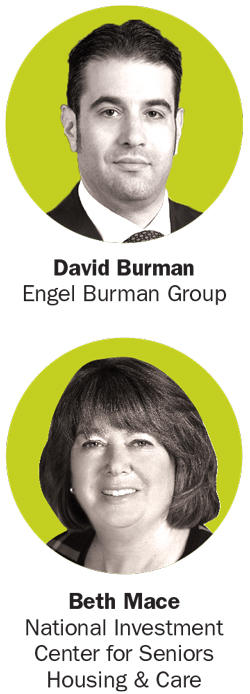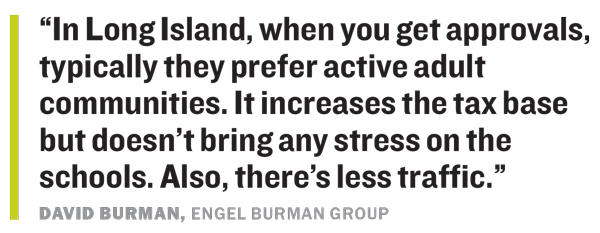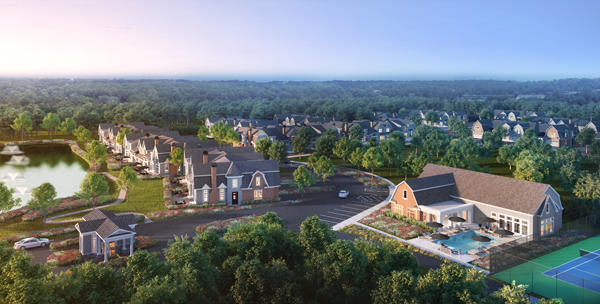Real estate is getting old.
If you hadn’t noticed, new senior living facilities are popping up all over the tri-state area. Aging baby boomers are fueling demand as they look to downsize to a maintenance-free lifestyle without leaving the area or giving up social ties. Developers are racing to get ahead of the so-called silver tsunami.
“The need for them in this community is tremendous, as it is all over the country,” said Elysa Goldman, director of development at Triangle Equities, the developer behind Kensington Estates, one such development in Woodbury, New York. That project broke ground this month.
Indeed, the U.S. Census Bureau estimates that by 2025 the 83-and-older set will rise to 10.2 million people, growing by 1.6 million people over the period from 2017 to 2025.
Beth Mace, the chief economist at the National Investment Center for Seniors Housing & Care, said that future demand has renewed interest in senior housing, and more capital is coming into the sector via public real estate investment trusts and private equity groups. That increased attention draws other investors, who see more transactions and want to get in on the action.
“More liquidity begets more investors,” she said. “It’s a circle that feeds into itself.”
Nationally, more than $13.6 billion in transactions took place in the senior housing and care sector in the second quarter of 2018, according to “Emerging Trends in Real Estate,” a 2019 report published by PricewaterhouseCoopers and the Urban Land Institute.
While senior housing assets are slightly riskier than traditional multifamily properties as investments, they offer higher payoffs.
Returns on senior housing can be as much as 11 percent, whereas for traditional multifamily buildings it’s more like 6 percent, Mace said, citing data from the National Council of Real Estate Investment Fiduciaries. However, certain types of senior housing require a different set of amenities and staffing from traditional apartment buildings, which can have an impact on profit margins in the short term.
A growing asset class
There are several types of senior housing, providing options for the elderly at different times in their lives.
 Some developers are building age-restricted condominium projects similar to Kensington Estates, which will offer 80 high-end units for buyers 55 and over.
Some developers are building age-restricted condominium projects similar to Kensington Estates, which will offer 80 high-end units for buyers 55 and over.
There are also “active adult” communities as well as independent living, assisted living and memory care facilities. The daily needs of the resident are reflected in the kind of development in which he or she chooses to rent. Active adults generally need the least amount of attention, while those in the memory care wing need more and are often located in a separate, contained area.
To that end, developers are looking to create campuses with numerous housing options to cater to the needs of the elderly as they age.
At the Delaney of Bridgewater, LCS Real Estate is combining independent living, assisted living and memory care facilities on one campus to provide “a full continuum of care,” according to a statement from the company. The senior living community broke ground in
September and is slated to open in the fall of 2020 in Bridgewater, New Jersey, with a total of 224 residences.
The budget for the project was over $100 million, said Dan Lahey, vice president and director of investments for LCS, which is based in Des Moines, Iowa.
That translates to a cost of about $475,000 per unit, he explained. Rents range from $5,000 to $6,000 for independent living and from $7,000 to $8,500 for assisted living and memory care.
In late 2018, LCS also acquired the Essex Meadows retirement community in Essex, Connecticut, Lahey said. The company is actively looking to expand in the Northeast. Lahey added that LCS has a contract on another site in New Jersey and is searching for more.
There has been a bit of a learning curve for the company as it expands into the Garden State, where land costs are higher and the entitlements process can take two to three times longer than in other states, Lahey said.
But whereas demand for senior living has been an issue in other areas, Lahey noted, that was not as much of a concern in the Northeast. “The supply-demand balance is better than many other regions,” he said.
Chipping at the margins
While demand may ensure occupancy, it does not guarantee profitability. And to get the developments off the ground in the first place, lenders naturally scrutinize every aspect of the project. Land costs are one of their biggest concerns, said Austin Sacco, first vice president of the national senior housing department at CBRE
Capital Markets.

He said basic buildouts could start at around $130,000 to $150,000 a door, but land prices will push the number up quickly. Additionally, in the tri-state area, that land is often more expensive than in other regions, especially the closer it is to New York City.
And since much of the desirable land has already been developed, projects are likely to be infilled or made to fit on a site developed for another building. That increases the costs too, Sacco said.
David Burman, a partner of Garden City, New York-based Engel Burman Group, further broke costs down for active adult communities on Long Island. The company specializes in senior residential and assisted living communities and has developed 20 assisted living communities in New York and New Jersey. It’s set to have five more in the area by 2021.
Land costs could start at $60,000 to $65,000 per unit of active adult housing, Burman said, noting that those numbers are on the low end.
Tariffs and construction labor costs have been adding to the bottom line, Burman said. The cost of materials has gone up, and projects in the tri-state area are often competing for quality construction workers, which means more money just to get people on the job.
Ongoing labor costs are another consideration, Sacco said. As seniors get less independent, they need more care. At an age-restricted active adult community, residents are almost entirely on their own, as in a multifamily development or other apartment complex. In an independent living community, residents are still mostly autonomous, but they eat meals together in a cafeteria-like setting, and there are bigger community areas with activities planned.
Assisted living and memory care are for those seniors who need extra help, and therefore additional staff is required.
“When the residents are largely frail and elderly, you need to ensure you’re able to staff it right,” Sacco said.
There’s currently a labor shortage for health care jobs, added Sacco. Workers can get comparable pay in other professions, so it can be hard to find and keep employees. Companies may have to pay more or offer more benefits to attract and retain staff.
In the pipeline
Despite the challenges, investors are diversifying their portfolios with senior housing.

In February, Triangle Equities broke ground on the 55+ community Kensington Estates in Woodbury.
“It’s more of a risk-reward tradeoff,” Mace said. And senior housing, in particular independent living and memory care, is thought to be more “recession-proof” because it’s needs-based.
As more and more projects go online, investor confidence increases because people see more opportunity to sell or expand in the future, she added. Some companies may also convert an active adult community to assisted or independent living to meet the needs of the area.
And instead of building traditional old folks’ homes on the outskirts of town, some developers are looking to build senior living communities in the heart of town.
Benchmark Senior Living, a national developer with projects in New York and Connecticut, is pushing for developments closer to walkable downtown areas, said Ken Littlefield, its vice president of construction.
“We want to build a more vibrant kind of community,” Littlefield said. “And that’s what clients are looking for, too. The next generation wants to be in a more built-up area.”
Benchmark is currently working on a project set to open this summer in Woodbury, and it recently opened communities in Fairfield, Connecticut, and Smithtown, New York. It’s also eyeing Dix Hills, New York, for its next build, Littlefield said.
Sales at Triangle Equities’ Kensington Estates started quietly this year. The sales process there is similar to other apartment buildings, just for an older clientele. Units range in price from the mid-$700,000s to $1.6 million, said Goldman, who expects closings to start in mid-2020.
The project was 12 years in the making, Goldman said, noting Long Island’s famous zoning hurdles.
Despite the long process, she said the towns were receptive to the project overall. For one, the development included a site that had been an eyesore and used as a dumping ground. In addition, the age-restricted project won’t affect the schools. “That’s a big deal in the community,”
she said.
Burman agreed.
“In Long Island, when you get approvals, typically they prefer active adult communities,” he said. “It increases the tax base but doesn’t bring any stress on the schools. Also, there’s less traffic.”
In addition, many locals are realizing they might want or need to move to such a community in the not-too-distant future. “It creates a bridge for care,” said Littlefield.
The response has been strong to Kensington Estates, which is Triangle Equities’ first foray into age-restricted housing.
“People have been waiting,” Goldman said. “We have a pool of interested people; the need is definitely there.”
